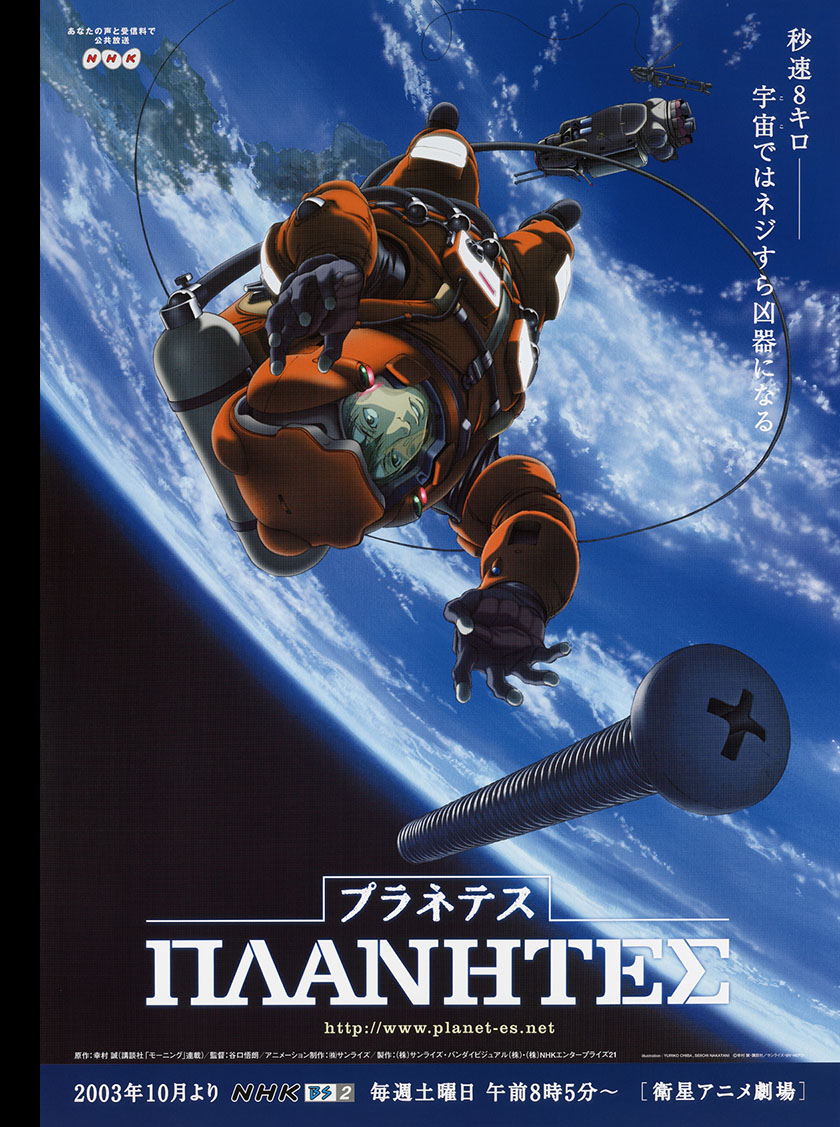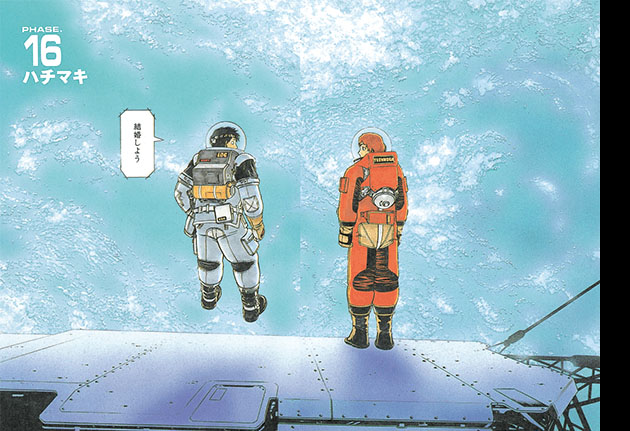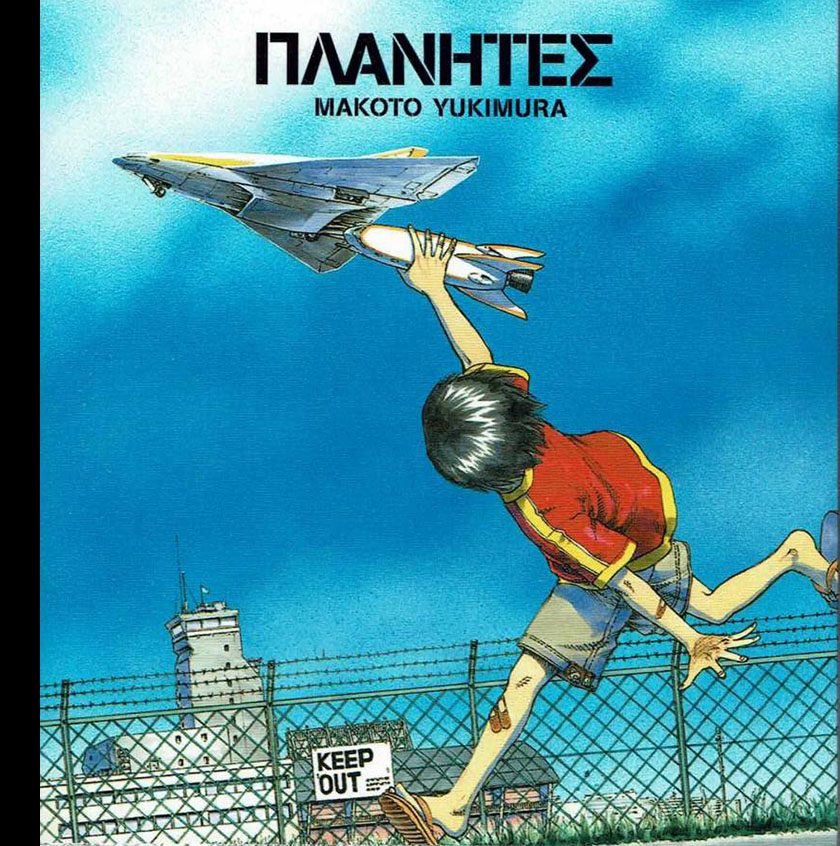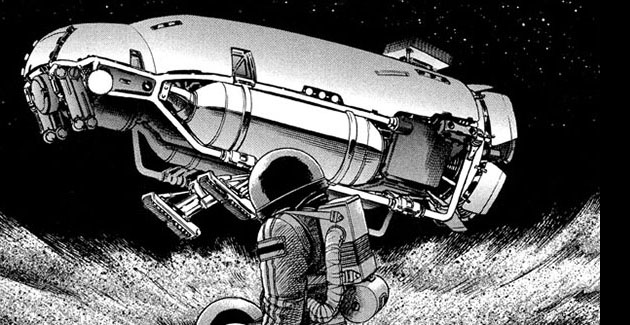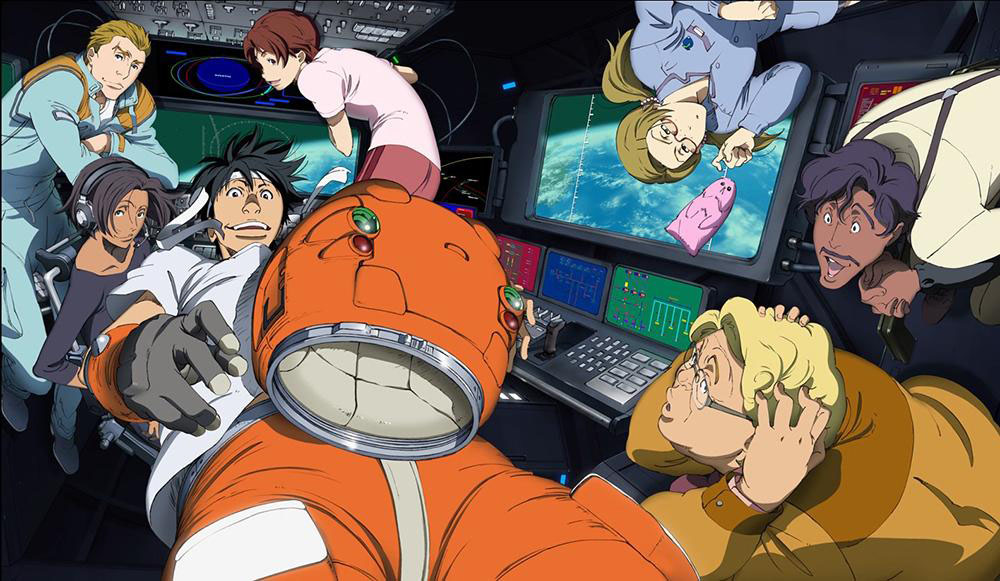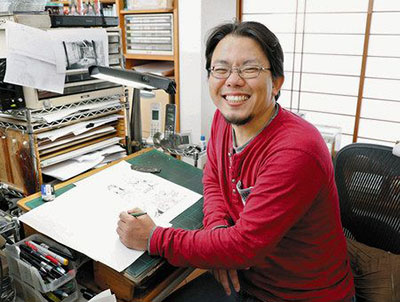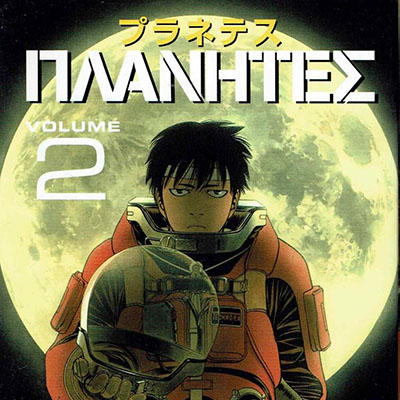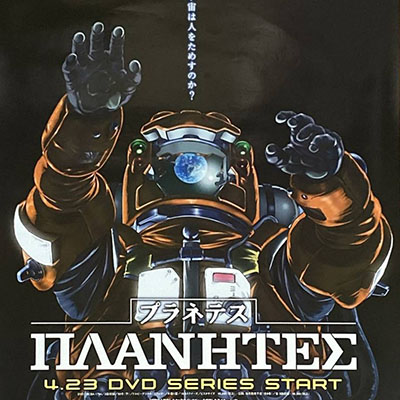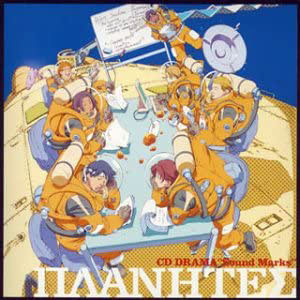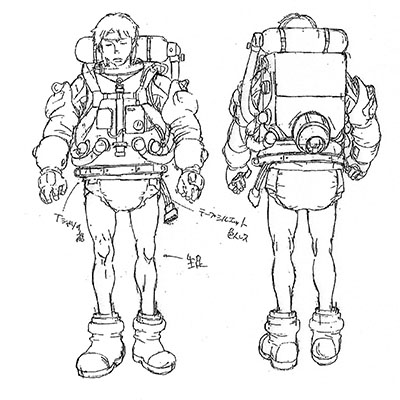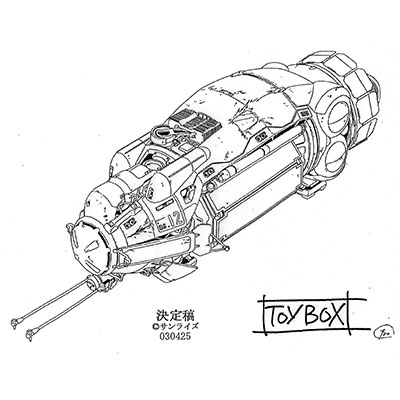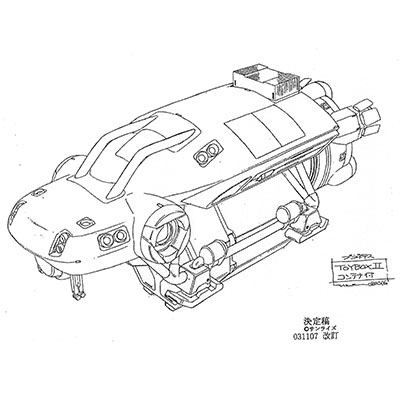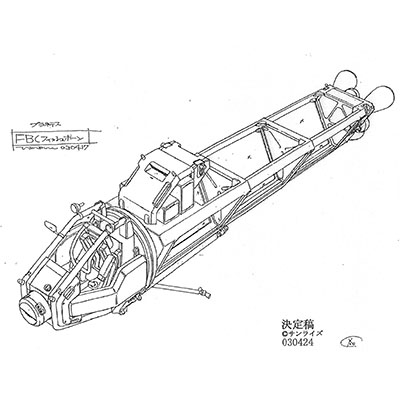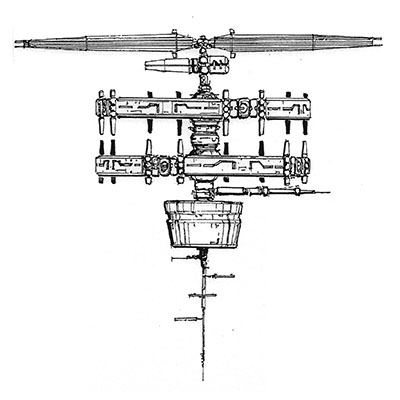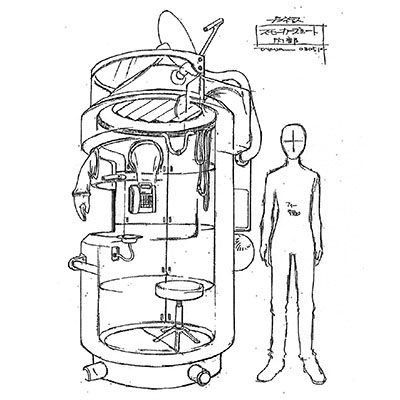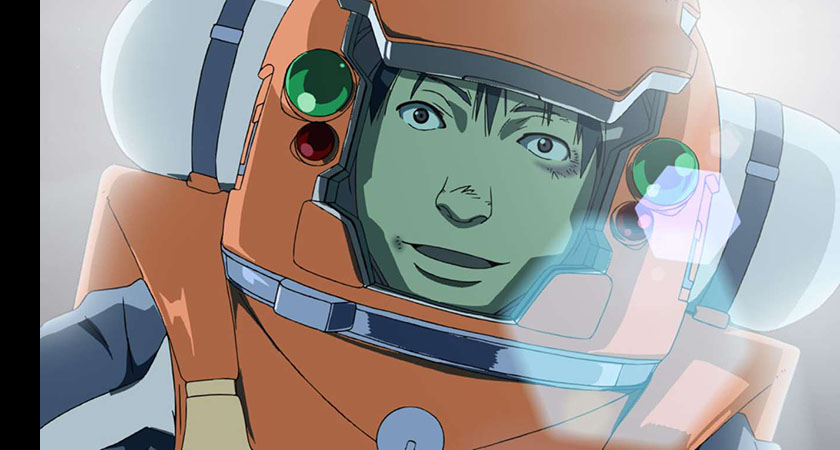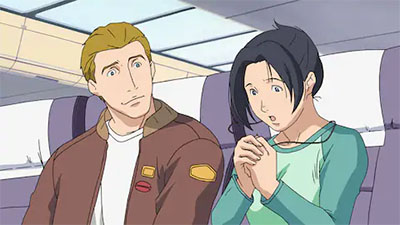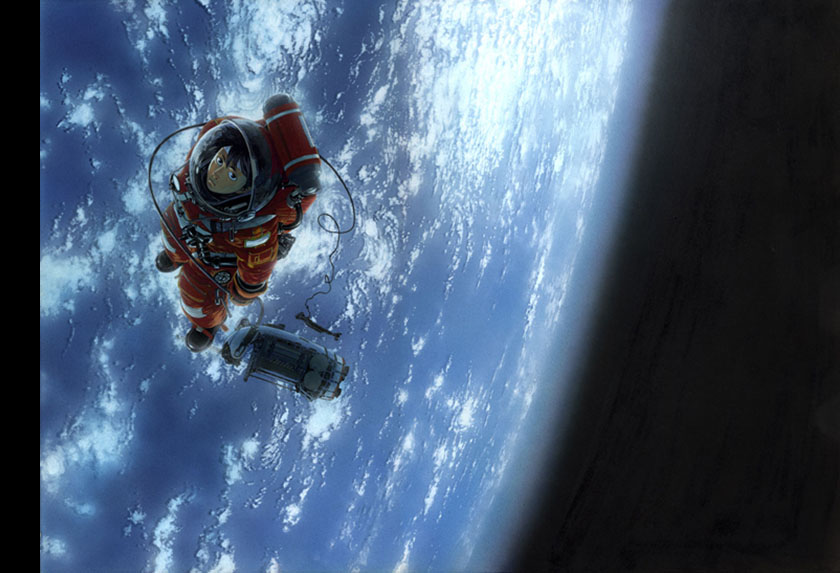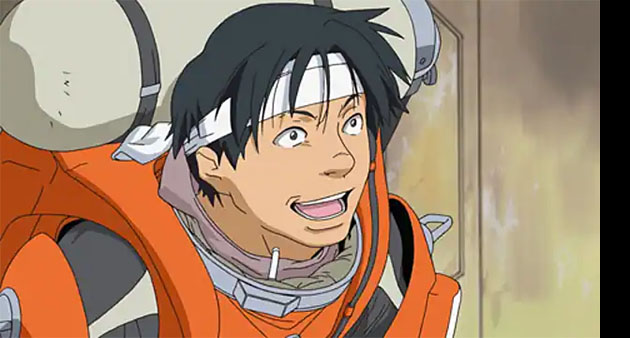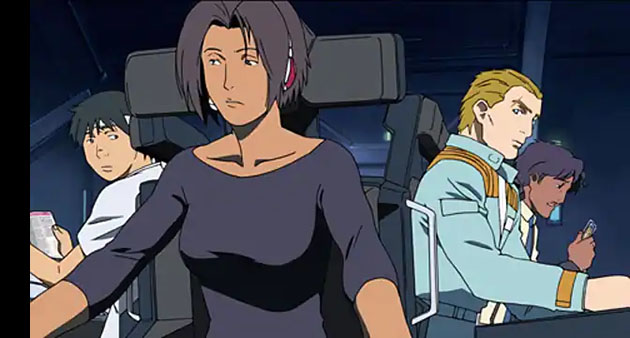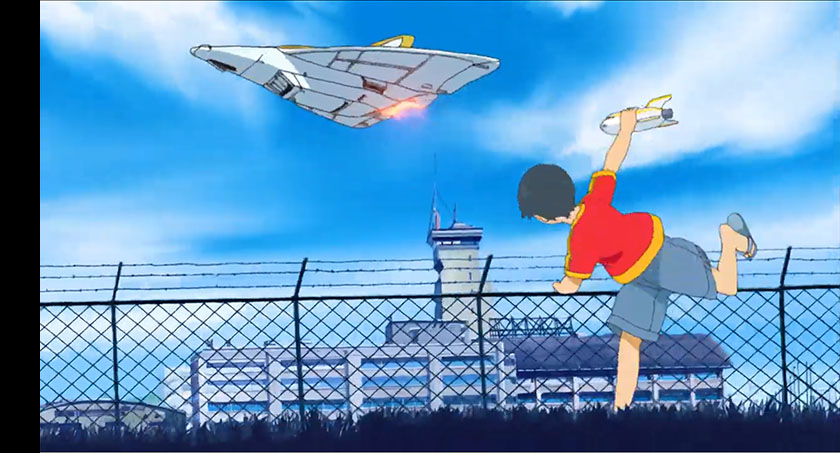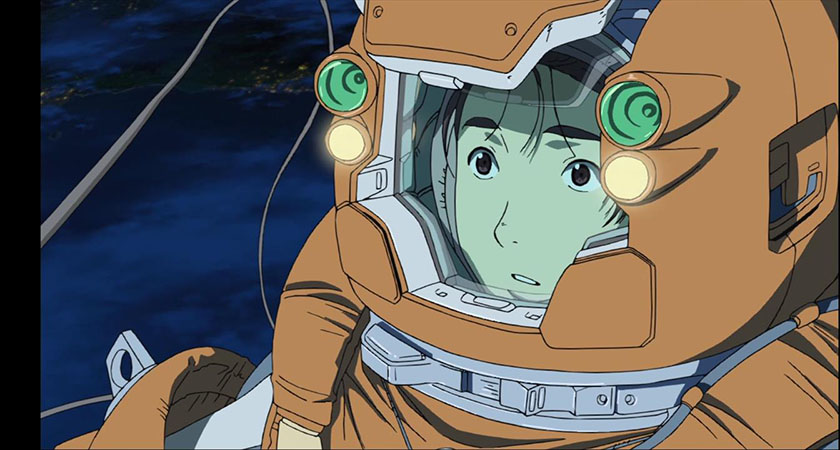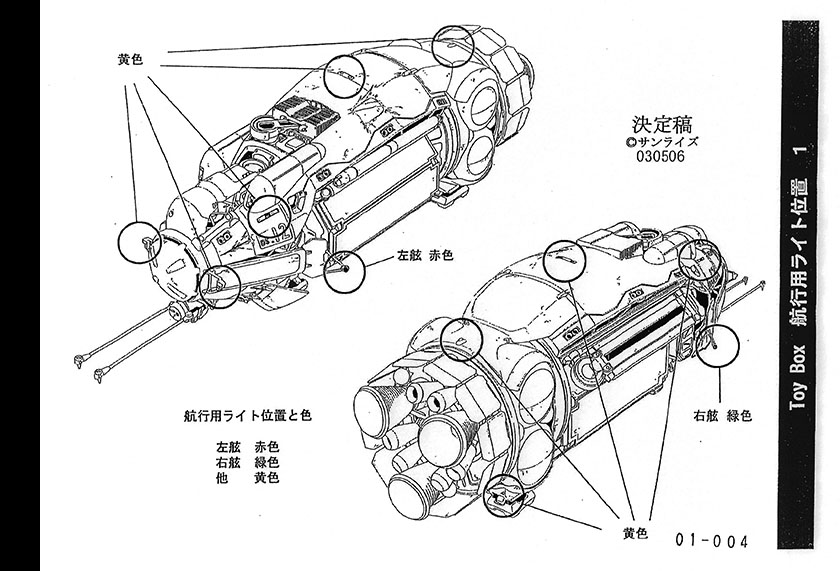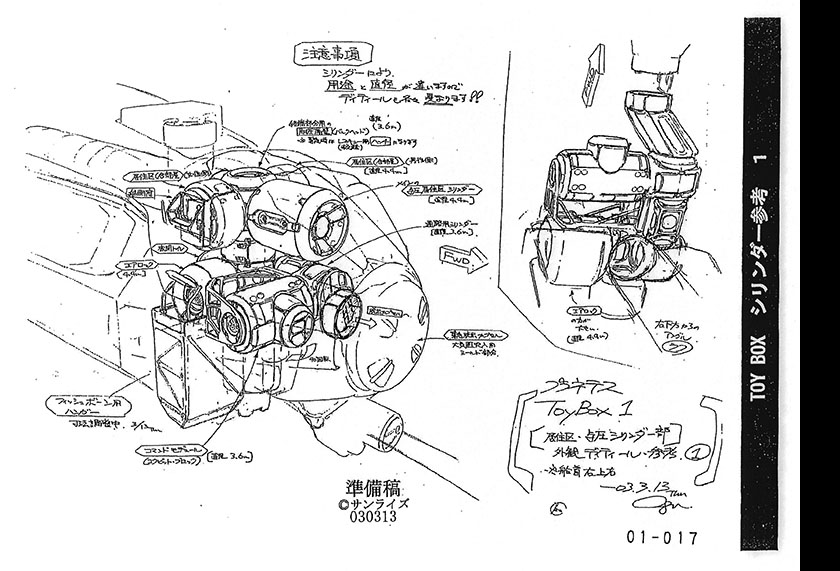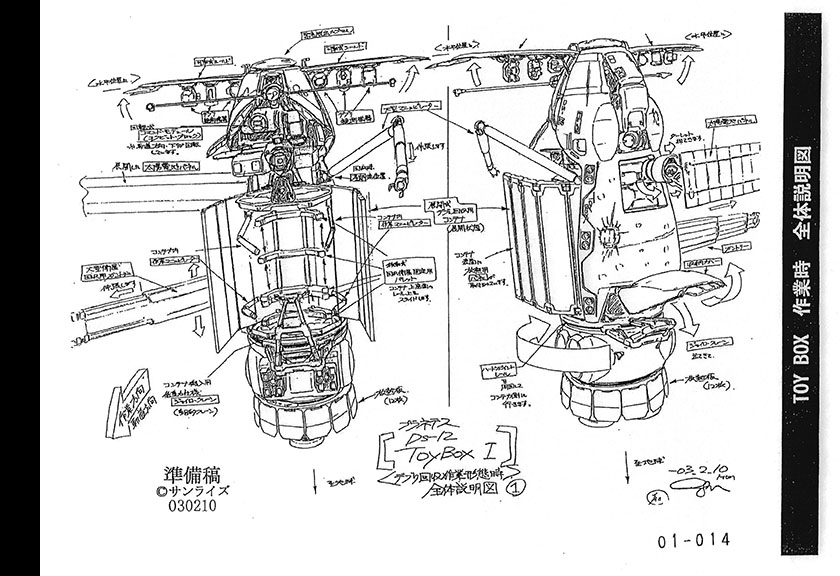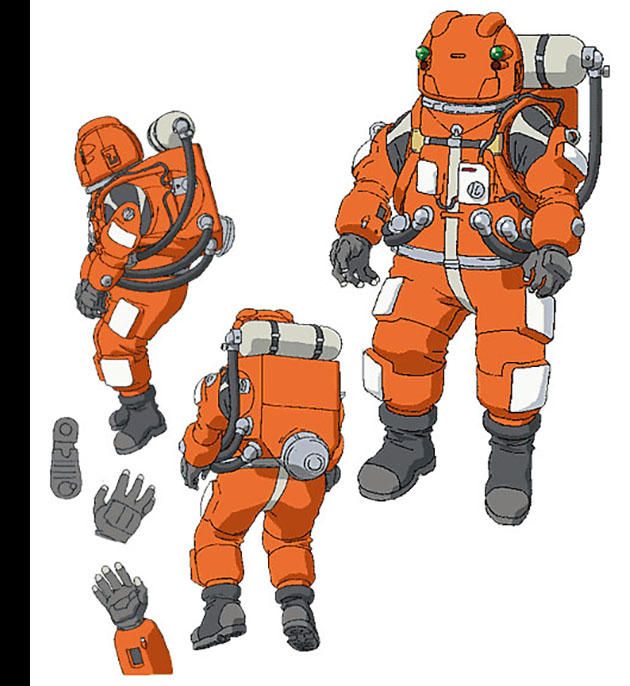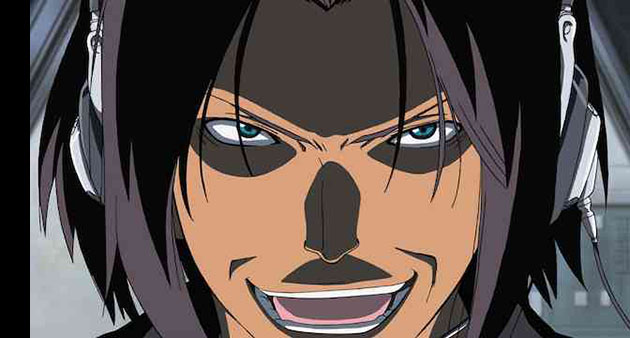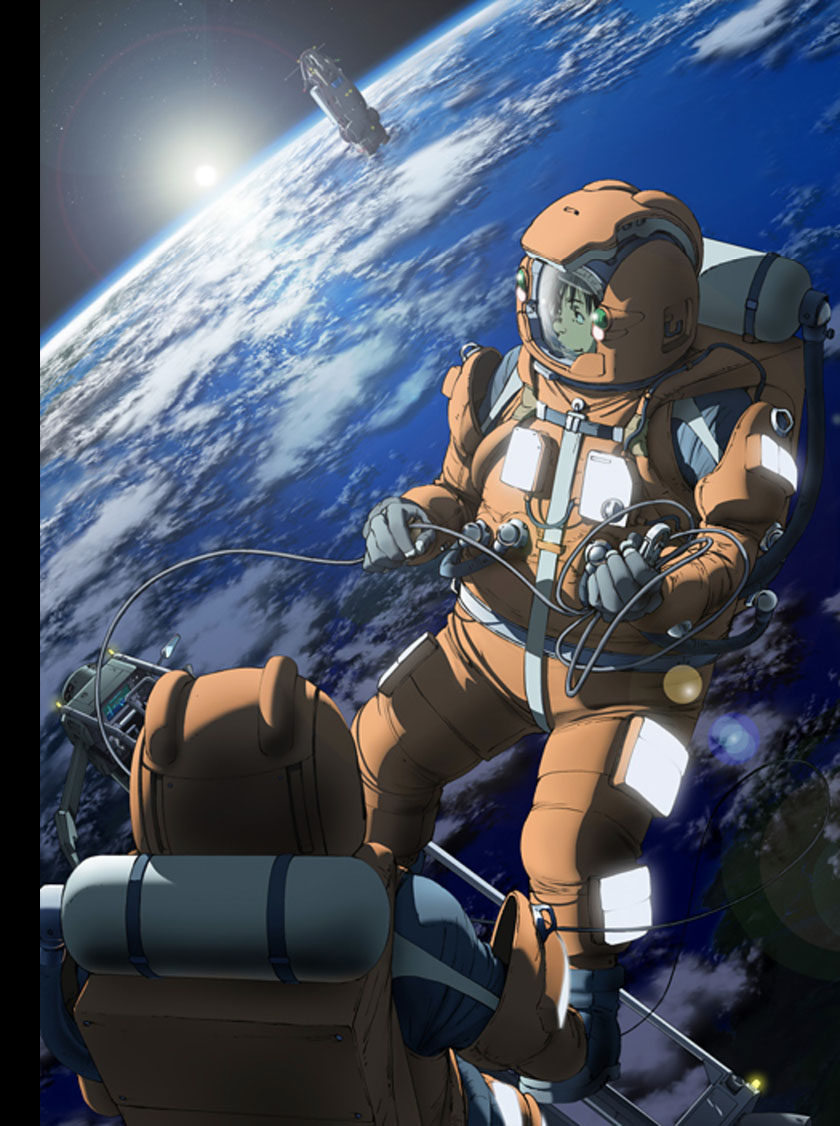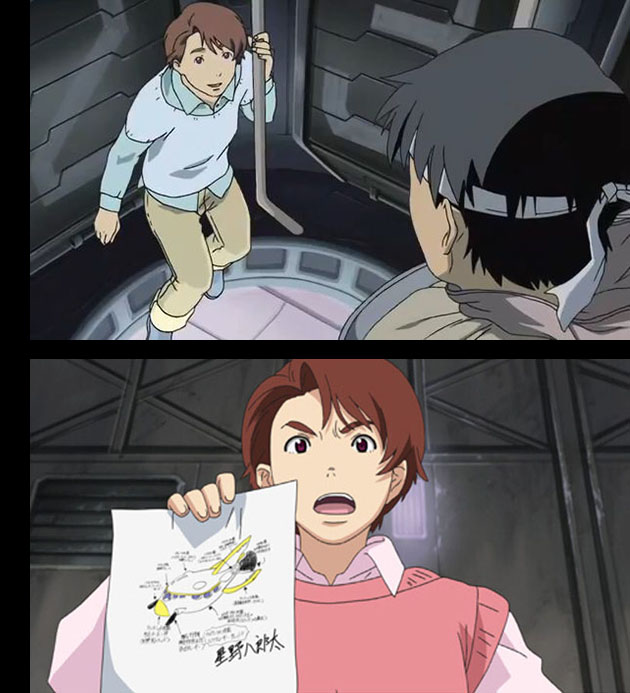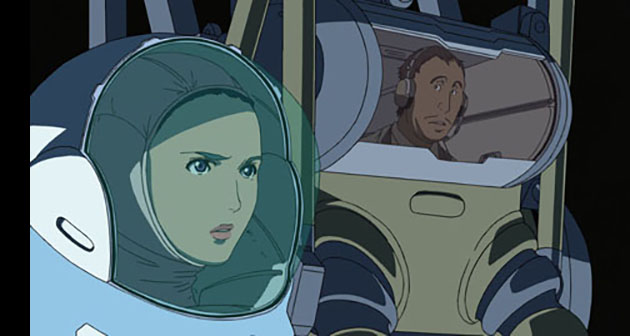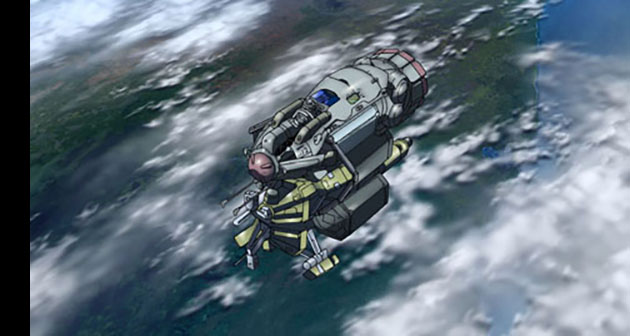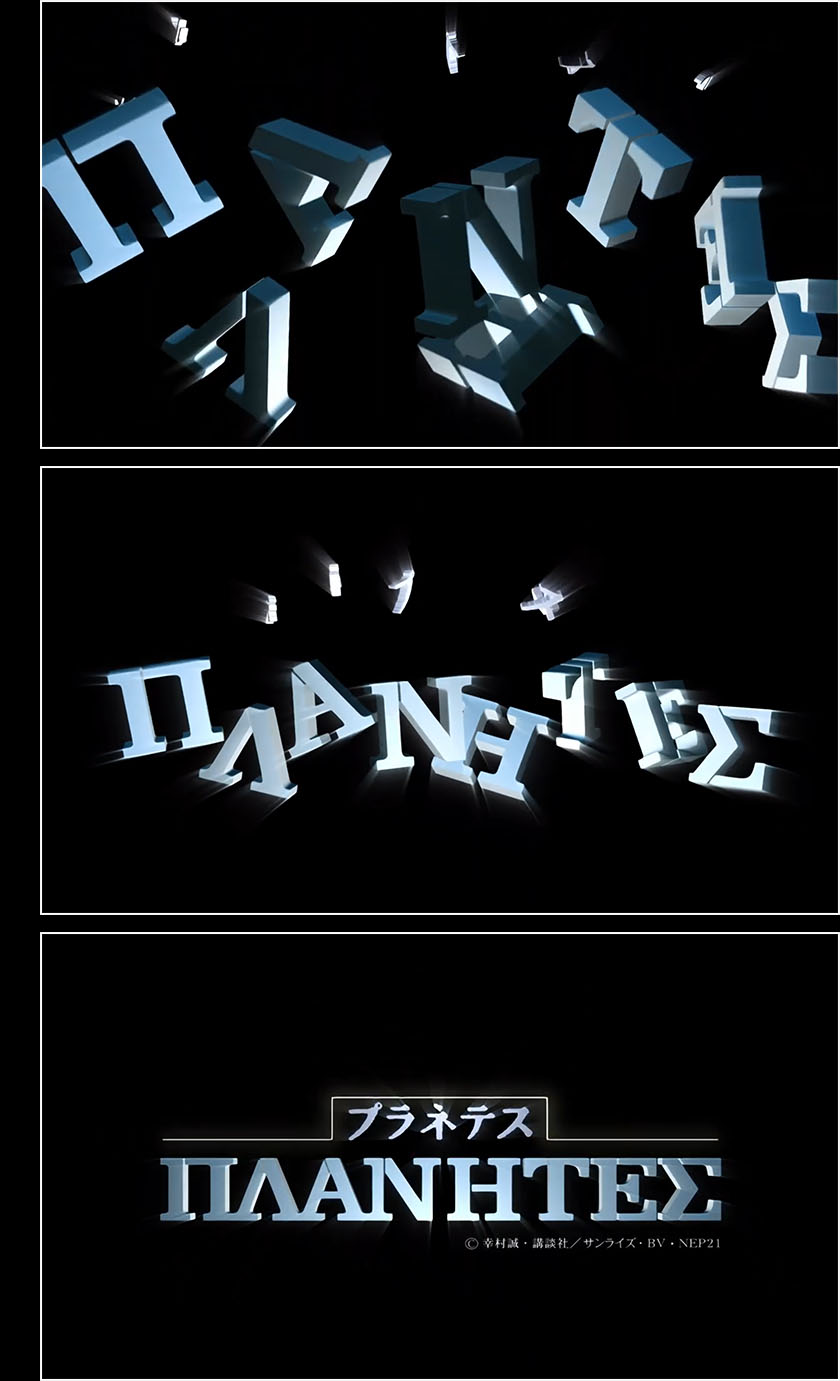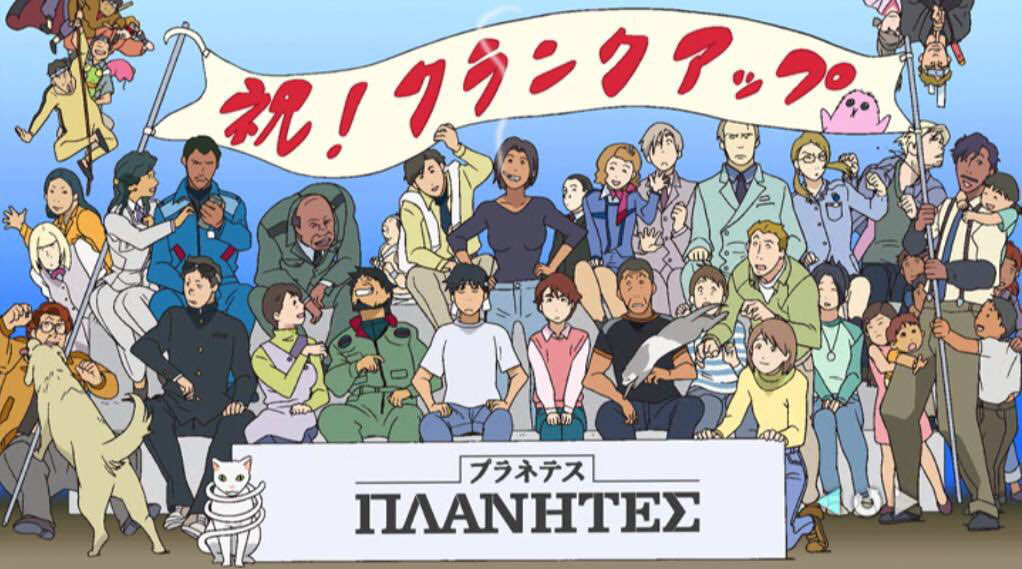Series profile: Planetes, 1999-2004
Let me start by pitching you a story. The main characters are trash collectors. They have diverse personalities, backgrounds and nationalities. They know they’re doing something vital, but their company doesn’t agree, and they are perennially underfunded with life gradually passing them by. Could you read a manga or watch an anime based on that premise?
Here’s something I left out: it’s the year 2075 and they work on a space station in Earth orbit. If that detail increases your interest, you’ve just felt the power of science-fiction to elevate the ordinary.
I don’t want to be the “actually” guy here, but when most people call something “science-fiction” they’re using the term wrong. But it’s not their fault. The “fiction” part has so totally stampeded over the “science” part that nobody objects when it takes over a story. There’s so little science in Star Wars, for example, that we might as well just label it “space fantasy.” Star Trek pays lip service to science, but quickly rewrites it whenever it threatens to get in the way.
The term originally denoted a balance between the two, science and fiction playing equal parts. In this balancing act, science is compelled to serve fiction and fiction is bound by science. The result is a genre that, at its very best, has tremendous predictive power about our evolution, with science as our ally against the dual opponents of bad luck and entropy.
Of course, humans bring their own messy conflicts to every party, and science can become a de facto super power in a fight between rivals. The point is, science is part and parcel of the story being told rather than a plaything to be disposed of when it becomes inconvenient.
After fantasy creep subverted the term “science-fiction” we needed another to describe this kind of story, and we settled on “hard science-fiction” rather than search for another one. This is the realm of authors such as Arthur C. Clarke, Andy Weir, Mary Robinette Kowal, and Makoto Yukimura, writer and artist of Planetes.
The title is derived from the Greek word for “wanderers.” It began in 1999 as an irregular serial in Weekly Morning, a manga magazine published by Kodansha. It didn’t appear every week because of its unusual length, with chapters running from 30 to 50 pages. 26 chapters were published through 2004, imported to America even before the series concluded in Japan. This momentum probably came from the fact that it won a Japanese Seiun [Nebula] award in the manga category in 2002. Which is quite a feat for a writer with no scientific background and who did no technological research for his story.
He won the award because he perfectly struck that balance I talked about earlier, telling a story about human hopes and failings in a future world made possible by science. The characters bear witness to a pivotal moment in human history, the beginning of the first flight to Jupiter, which pushes the wealth gap between classes and nations of Earth to its long-overdue breaking point. Planetes wields the predictive power of hard science-fiction by “borrowing” a story from the future that illustrates a credible outcome of today’s neglected problems. This is what science-fiction excels at (hard or soft) and it’s what lands Planetes on my list of top ten favorite stories to come out of Japan.
I first experienced it in manga form when it was imported by Tokyo Pop in 2003. The “trash collectors in Earth orbit” angle hooked me instantly. It sounds mundane, and that’s where the charm lies. A mundane job of the future can fascinate us today in the present, and subtly remind us how vital menial work like trash pickup really is. Imagine if your sanitation service stopped right now. You could maybe tolerate it for a couple weeks, but then it would quickly become dire. One month in, you’d pay that menial worker whatever they wanted to resume service.
It’s even more vital in an orbital scenario. The layer of freefloating debris around Earth has already reached alarming levels today, and every single piece is flying many times faster than a bullet. You can’t get anywhere without passing through that debris layer, which makes anyone willing to clean it up a critical component of the entire future. But, just as you may expect, they receive no more respect than the average menial wage slave of our time.
It’s easy to picture the state of affairs if that job wasn’t tended to. And in Planetes, the subject of space debris suddenly becomes the single most important factor on Earth when a terrorist group plots to create a lot more of it. I absolutely love stories like this, governed by and told within the confines of real, inescapable science. My own SF webcomic Pitsberg works within the same parameters.
I knew Planetes was going to rocket up my favorites list as soon as I reached the end of chapter 1, which was so achingly sentimental it brought me close to tears. I could go on and on about that chapter alone, but I don’t want to spoil it for you. I expected the focal character to be the lead from then on, but he was quickly relegated to secondary status when the ranks filled up with even more interesting primaries. The actual main character is Hachimaki, whose EVA specialty and hard-boiled stubbornness soon propel him toward the Jupiter mission and a head-on collision with history.
I was overjoyed when I learned that a 26-episode anime version was made. It ran in Japan from October 2003 to April 2004 and was imported to the US on DVD by Bandai Entertainment in six volumes from 2005-06. The story was structured differently and added many more characters, going on to earn its own Nebula Award in 2005. The only other title to win twin Nebulas in this fashion was Hayao Miyazaki’s Nausicaa.
On the other hand, as soon as you commit to certain technologies in a story about the future, you run the risk of real time overtaking you. As I write this, it’s been less than 20 years since the anime was made, but some of it is already obsolete. For one thing, it was utterly blindsided by smart phone technology. Handheld devices seen in the TV series are comically oversized and specialized, most of them having since been consolidated into a single pocket-sized screen. The only remedy is to look past this and admire everything else that was so meticulously conceived. (Your respect for that will go up when you read some of the staff interviews below.)
Both versions of the story naturally have significant overlap, but also deviate from each other in significant ways. The anime spends much more time on the culture of a space community, whereas the manga takes deeper dives into individual psychology. Both are highly tuned in terms of emotional intelligence and political awareness. The story is larger than any individual involved, but is driven at key points by those same individuals. It’s that precise quality that transcends genre and defines a masterpiece.
For me to go on and on about this series would just wear you out and spoil the story, so from here on I’ll let the work itself do the talking. As you can guess, it has a lot to say.
DATA
Synopsis (via Wikipedia):
The time is the 2070s (after 2075). Space resources are being developed on a commercial scale, including the mining of helium 3 on the moon. There is an experimental habitat on Mars, and plans are underway for manned exploration of Jupiter and Saturn. Every day, high altitude passenger planes travel back and forth between orbit and space. Many people live and work in space stations and on the Moon.
However, space debris (discarded satellites, rocket debris, etc.), which has been created in the shadow of the long history of space development, has overflowed in orbit. It has become a social problem. In addition, the problems of poverty and conflict on the ground remain unresolved, and the benefits of space development are monopolized by developed countries. As a result, the problems of terrorism due to poverty and ideology are also unresolved.
The protagonist Hachimaki is a salaryman working in space. His main job is to collect debris. He dreams of one day owning his own spaceship. While convincing himself that picking up trash is important work, he is torn between his original dream and reality. Should he still pursue his dream?
Makoto Yukimura (born 1976) made his manga debut with Planetes in 1999. He then went on to create the award-winning historical drama Vinland Saga in 2005, which is still being serialized in Monthly Afternoon magazine and has been adapted to anime and is now streaming on Amazon Prime.
Original publication by Kodansha; serialized in Weekly Morning from 1999-2004 and reprinted in four paperbacks.
First English publication by Tokyo Pop (5 volumes), 2003-05. Second publication by Dark Horse (2 volumes), 2015/16.
Anime first broadcast (26 episodes) 2003-04. First US import by Bandai Entertainment (6 volumes), 2005-06. Region B Bluray released in 2021 by All the Anime (UK).
Episode 10, The Sky of Stars, was re-edited by Goto Optical Laboratory for planetarium screenings all over Japan.
See the entire anime series on Youtube here!
(26 episodes; 4 subtitled, 22 dubbed)
Official Japanese website (Bandai/Emotion)
Anime News Network page on the anime
Anime News Network page on the manga
Promo for Japanese blu-ray box (subtitled)
Region B Bluray ordering info at All the Anime
Complete manga online (Japanese edition)
Source A | Source B
Both soundtrack albums on Youtube
All versions of the OP title compared
Opening theme Dive in the Sky, full version by Mikio Sakai
Dive in the Sky with space history montage
Ending theme Wonderful Life, full version by Mikio Sakai
Insert song Thanks my Friend by Mikio Sakai
Earth montage set to Planetes Affettuoso
Production staff interviews
Goro Taniguchi
Interviewer: Please tell us about when you were asked to direct Planetes.
Taniguchi: I think it was around last summer, when Mr. Uchida from Sunrise asked me for my opinion on a project he was planning. He showed me the manga. I had read about it in Morning, so I knew what it was about. I liked the story very much, but it was hard to keep it going. I thought it was a manga that was published, but I forgot about it. (Laughs) Mr. Uchida told me that he wanted to do it in 2 arcs (26 episodes) on TV. He asked me to give him my opinion on what kind of staff could do it.
Interviewer: What was your opinion at that time?
Taniguchi: I thought it would be impossible. (Laughs) There weren’t enough chapters in the original work. It seems that it originally started as a read-only series, so if we were to make it into a TV series, we would have to make a lot of changes.
I remember saying, “This worldview is too much of a hurdle for TV anime.” But I decided that I would rather do it myself than have someone else do it. It seemed that the people from the companies involved in this project were also determined to do it. As a freelancer, it’s not often that I get the chance to work on a project like this.
I also thought it would be a good challenge for me, since I’ve been away from original works for a while. When I actually started on it, it turned out to be just as I expected. It’s an original work that is worth challenging, so I’m fighting with it every day.
Interviewer: What kind of work do you want the anime version to be? What do you want to do with it, and what do you want to tell the viewers?
Taniguchi: As I said before, with 26 TV episodes, there were a few things that needed to be sorted out. If you don’t add more stories, it will end too soon. On top of that, there’s the number of viewers. Because TV is such a big medium, we want people who don’t know the original story to see it. If you want people to enjoy your work, you need to make it easy to understand.
But it’s not about patronizing anyone. If you want to say something challenging with a work that won the Nebula Award, it’s no good if you make the audience think, “Oh, SF, that looks complicated.” I don’t want to ignore fans of the original work, but I want people to think, “Oh, there’s a work like this out there? I’ll read the original.”
Mr. Yukimura, the author of the original story, is a very flexible person, and he allows us to work freely. We want to help expand the world of Planetes.
Interviewer: For that reason?
Taniguchi: I don’t want to exaggerate too much, but for the TV show, we brought an “office worker” sensibility to it. The debris collection business is a division of a huge corporation. Inevitably, there will be new characters in the company and Hachimaki’s friends. I wanted to introduce Tanabe earlier, so she’s there from the first episode as a new employee.
By overlapping the macro perspective of outer space with the ridiculous perspective of everyday life, I hope it will affirm, in a positive sense, the smallness of human beings, their suffering, their struggles, and their dreams for the future and space. All of us are working hard to make it an anime version to be enjoyed by fans of the original and those who don’t know about it.
Ichiro Okochi
Interviewer: How did you first get involved with the Planetes anime?
Okochi: Rather than being approached about Planetes, I was approached because it was a new work by Director Goro Taniguchi. I liked his series Infinite Ryvius, and I had been interested in his work for a long time, so I accepted the offer as soon as Taniguchi was named as the director. It was after that that I found out Planetes was the original work, so I bought the manga.
I read the first chapter and…I was troubled. (Laughs) It’s interesting. And it’s pretty much perfect. I didn’t have to add or subtract anything at all. So you might think it’s easy, but this is not the case. The manga and the anime seem to be similar, but they have different strengths and weaknesses. If you simply copy the original work, you will end up with a degraded copy.
That’s why I’m currently struggling to create a different kind of appeal while not killing that of the original work. I’m still working on it.
Interviewer: You’re writing all 26 episodes. Isn’t that unusual for TV animation?
Okochi: Yes, it is. It’s more common for multiple scriptwriters to take turns writing. I was planning to do the same at first, but Director Taniguchi suggested that I write the whole thing myself. (Laughs) Well, that’s when I got the idea. I’m so naive, aren’t I? (Laughs).
It’s true that it’s easier to control when you write alone. However, it’s tough to have to create various “tones” by yourself. In particular, Planetes has a lot of different tones, such as tragedy, gag, romance, ninja, etc. I hope it will be a variety show in a good way, so you can enjoy a different story every time you watch it, while keeping a sense of unity as a work.
Yoshitaka Kawaguchi
Interviewer: What was your first impression of the original Planetes?
Kawaguchi: I happened to read one of the chapters in Morning. I remember a scene where a Hummer-like car is driving on the highway on the moon. My impression at that time was, “The highway on the moon is nice! This car looks like a Hummer, so it’s cool!” I’m a car lover, so that was the extent of my impression. I read the book afterward, and I thought, “The future space society in which the story takes place is very well thought out.” The fact that he chose debris as his subject matter shows that he is a writer of the new generation.
This work has the strong personality of its author, and I felt that the animation staff would not be able to deal with it if they went in half-hearted. To put it simply, would there be any appeal in Planetes if it was drawn by someone other than Mr. Yukimura? That’s what I mean.
After that, I was asked if I would be interested in being the on-site producer for the series. For the reasons mentioned above, I was reluctant. However, when I read the concept memo by Director Taniguchi and the prototype script by Mr. Okochi I thought, “I might be able to deal with this.”
Interviewer: What kind of work do you want the anime version to be? What do you want to do with it?
Kawaguchi: I want to make a program that fully conveys the appeal of the original. We also want to add our own unique appeal to the show.
In fact, the first episode of the TV version is not based on the original story. Normally it would be, but for this one, director Taniguchi and his staff worked so hard on Planetes that they felt the need to make the first episode unique to the TV version. In addition, the first episode is the beginning of a challenge to see how we, the anime staff, who are not Yukimura-sensei, can create the appeal of Planetes in our own way. Of course, the evaluation will be left to the viewers, but we are confident!
Interviewer: What is the atmosphere of the production site? What kind of people are on the staff?
Kawaguchi: Director Taniguchi and his team work well together. It’s about 50/50 between those who have worked with Taniguchi and those who haven’t. They’re busy communicating with Taniguchi and giving instructions to each unit. Mr. Okochi, who is in charge of scripts, is also in the studio, and he plays the role of absorbing the opinions of the staff.
On the drawing side, the animation director, Yuriko Chiba, is a key person. I asked her to do the character design as well. By taking the slightly masculine characters of the manga and putting them through Ms. Chiba’s hands, we could add a “casual sexiness” to them. In response to Ms. Chiba’s technique, the animation director and other animation staff are currently working hard on each episode.
The background unit is now working with the CG unit to develop the 3D Earth, moon, and space station. In particular, for the 3D Earth, we prepared a background the size of several floor mats (which is still a small part), and created a very render-heavy, high-resolution Earth. The secret highlight of Planetes is the CG in the background, including this Earth.
In addition to all that, the Taniguchi crew is also involved in the color, photography, editing, sound, and music.
Interviewer: What’s the atmosphere at the voice recordings, with Mr. Uragami, the sound director, and the actors?
Kawaguchi: Mr. Uragami is a big name in the industry and has worked on Director Taniguchi’s Ryvius and S-CRY-Ed. Mr. Taniguchi requested that Uragami-san be the sound director.
As for the actors, I was particularly impressed with Kazunari Tanaka, who played Hachimaki. He played occasional roles in my previous shows King Gainer and Turn A Gundam, but this time he plays the main role. This is the first time for him to play a leading role in a TV series. When I looked closely at his face during the first recording session, I noticed that he looked somewhat like Hachimaki. Especially the eyes. I was convinced that it was a good idea to cast him.
Yuriko Chiba
(This interview was conduction while episode 13 was in production)
Interviewer: You’ve reached the turning point at #13. What are your honest impressions after working on it so far?
Chiba: Episode 13 already! But still 13 episodes to go! That’s how I feel. This work is very dense, isn’t it? It’s hard to have fun, but I’m going to be so sad when this is over. Even though we’re at the middle, I still think about it because the final script is being written now.
Interviewer: There are some characters in the anime that are not in the original story. Are there any that you’re particularly attached to? And why?
Chiba: Do you mean among the original characters? I get asked this a lot, but it’s really hard to answer this kind of question. What would be the best way to answer? Answering “All of them” is not interesting.
It’s Claire… But I also like Lucy and Chenshin. I like Lavi, the chief, Edele, Tanabe’s friends, Hachimaki’s colleagues, Dolph, Dr. Gigalt, Colin, the ninjas… I’m sorry, please forgive me.
Interviewer: What kind of people are Director Taniguchi and Mr. Okochi from your point of view?
Chiba: Why am I the only one who gets these questions? Are we doing anything better than we did before? Well, they’re very good-looking, talented…but I’m a scammer. That’s a compliment, of course. Directors and screenwriters have to be frauds. I’m so happy to have been able to work on this series, directed by Goro Taniguchi and written by Ichiro Okochi.
It’s true, Mr. Director, Mr. Okochi. Please continue to let me dance in the palm of your hands. I will dance with 1.5 times my previous strength.
Interviewer: The character design for Planetes seems different from what you’ve done for other works. Did you have any ideas going in what you might do for Planetes?
Chiba: As always, I don’t have the luxury of just saying, “Let’s do this!!” I’m struggling to draw while enduring the pressure of what to do, what to do. Sometimes I don’t think I can do it, but then I think about how to incorporate the real part, the manga part, the part where I put a lot of pressure on myself, and the part where I relax. I would like to draw each character as vividly as possible, to make it fun and enjoyable for everyone to watch.
Whether you’re a fan of animation or not, you may say, “Oh, it’s time for this manga drama, which I happened to watch last week and enjoyed a little. I think I’ll watch it again this week.” And when you finish watching it, I hope you’ll think, “Oh, that was fun.” That’s what I think about as I draw the characters and do the artwork.
Mikio Sakai
Interviewer: You participated in S-CRY-Ed, also directed by Taniguchi. How did you get involved in Planetes?
Sakai: I was approached by a producer from Victor, with whom I worked on S-CRY-Ed. I’m grateful for that. I felt that my previous work had opened up a world for me that I hadn’t seen before, so I had a feeling that another door would open for me this time.
Interviewer: How do you feel about the OP and ED of the anime?
Sakai: The OP is very cool. It shows the grandeur of outer space and expresses the strong will of human beings who have advanced into space with their hopes and dreams. The flow from the intro is also good, and it’s an excellent OP. The part in the chorus where the “light” and the video sync together was very moving.
As for the ED, it’s a natural work with a relaxed attitude. As you can see, it depicts the growth process of a person, so I’m sure everyone can relate to it. It made me think back to the pure initial impulse I had as a boy.
Interviewer: What kind of image did you have in mind when you wrote the music and lyrics?
Sakai: The OP is a song of great praise. I think it’s an amazing thing for human beings to jump out into space. After many failures and hardships, we finally got there. I wanted to praise the strong will of mankind to advance science and technology. I think it turned out to be a very powerful song.
The ED is a cheering song. It’s a song for working people who have finished a day’s work and need to take a breather. I’ve been through a lot, but the fact that I’m here, living like this, despite everything…it’s a wonderful life.
I feel that many people today overlook the joy of life. If we just change the way we look at things a little, we can have a richer life. I wrote the lyrics with that feeling.
Interviewer: You said at the time of the recording that songs like this OP are rare these days. You were creating a very elaborate sound with many layers of chorus. Did you find it challenging?
Sakai: To tell the truth, when I’m recording, I feel the music most when I put in the chorus. So it was very rewarding. I think the voice, unlike other instruments, is allowed the most freedom in a song. This time, I let it run wild in all directions. One voice is weak, but when you put two or three voices on top of each other, it becomes a wonder.
Is it Yangtze River? No, the Pacific Ocean? It becomes so dense and strong, it feels good. Even if you turn off the other instruments and listen to the chorus alone, it’s still cool. But it’s physically exhausting. I wonder if I’ll able to do that kind of recording when I get old. (Laughs)
Note: the opening and end themes of Planetes can be heard on Mikio Sakai’s 2012 album My Souls. Listen to the entire album on Youtube here. It’s also available for purchase on Apple Music.
Kotaro Nakagawa
Interviewer: You participated in S-CRY-Ed, also directed by Mr. Taniguchi. How did you get involved with the anime Planetes?
Nakagawa: I heard that Mr. Taniguchi, the director, recommended me for the project. Is that true? If so, I’m very happy. I’ll have the courage to ask him next time I see him. In that sense, I guess you could say that my participation in S-CRY-Ed was the start of it.
I’m sure you’re all familiar with Taniguchi, but whenever I meet him, I always feel that his passion, love, and enthusiasm for his work are so great that there is no end to what I can say. After each meeting, I would always think, “I will definitely make good music for this director! I will definitely live up to the his love for his work!” That’s how I feel.
It was the first time in a long time that I heard the sound of bells ringing in my heart. To be honest, I don’t think I’ve heard this sound since S-CRY-Ed.
Interviewer: What are your honest impressions of the anime? Especially about the way music is used.
Nakagawa: It’s very interesting. You may think I’m pandering when I say it like this, but I’m definitely not. I’m a hardcore anime fan, so there’s no doubt in my mind. The characters are rich in emotion and expression. In addition, the music is wonderfully timed! I think it makes the story even more exciting. (I’m praising myself. I’m sorry).
Interviewer: This time, you used Japanese instruments, which is a different taste from the others. Is there anything you imagined when writing for them?
Nakagawa: Space is dark and lonely. Of course, even if you shout, your voice won’t penetrate it. If something happens, even a small accident, your life is immediately at stake. If you think about it, it’s a terrible place! But there are people who are fascinated by such places. I wanted to express such a place and people, so I brought in Japanese instruments; Shakuhachi, sho, and shamisen.
These three sounds can embody various emotions, from the blind heart of a person who is possessed by something, or the abyss of the universe that swallows up all kinds of emotions, from shallow human schemes to love, respect, fear, jealousy, anger, and sadness. These are the symbols of the music I play. I hope some of you will be able to feel something from my music.
Interviewer: Are there any difficulties or joys involved in making music for anime?
Nakagawa: There are a lot of people involved in the process of completing a work, but in terms of detail I’m only aware of music, so I will tell you that more than 40 musicians work hard to achieve a single goal. The sound you hear on TV or a CD is the culmination of 40 people, each with the best technique and the greatest passion.
Of course, it is my score that will be played. Isn’t it great to be a composer? Anime has a depth of feeling that allows it to accept and incorporate any kind of music. This depth is both a pleasure and a challenge. If the music is not good enough, it will be upstaged by well-crafted visuals. Especially this time, since it was directed by Taniguchi. So I put my heart and soul into it.
Shinya Ogura
Interviewer: How did you get involved in Planetes?
Ogura: In the fall of 2002, I received a phone call from a producer named Shigeru Horiguchi. He said, “We’re going to make an anime of Planetes at Sunrise. I’d like to introduce and recommend you as a consultant.” I was very surprised! (Laughs)
The Planetes manga itself was recommended to me by my senior, Shigeru Morita (of Studio Nue), who told me about this interesting manga. I read it and was impressed by the fact that someone drew such solid SF. I never imagined that it would be made into an anime. I don’t think there is any other anime producer other than Sunrise who would want to make a full-fledged anime of this work.
It’s not easy to get a job drawing a real spaceship. Mr. Horiguchi is a person who is very particular about his work. “When it comes to spaceships, Ogura is the go-to guy!” In my work, I’ve earned a reputation of, “get Ogura for spaceships!” As a pro, I couldn’t be more honored. I wanted to participate in this project to repay Mr. Horiguchi for his trust in me.
And when I heard that Goro Taniguchi was the director, I thought it would be very interesting. I was especially impressed by the image at the beginning of the first episode of Infinite Ryvius. I thought he was going to do something very serious. In fact, at our very first planning meeting, he said to me, “I want to surpass the first episode of Ryvius!” I was suddenly motivated when I heard his determination. I was so happy! I think we were able to do this well enough in the first episode of Planetes, especially in the launch scene!
I didn’t know that the scripts would be written by Ichiro Okochi. I only found out about it when I met him at a planning meeting. I was surprised, but at the same time I was impressed that we could work together. He himself says that he doesn’t have a style of his own, but the proof is that he’s able to adapt to a variety of works. That makes him a real professional screenwriter. “This is going to be a fun,” I thought.
And that’s how I got hooked on the anime Planetes. (Laughs)
Interviewer: Was there any pressure in working on the setting and concept design?
Ogura: I think it would be disrespectful to Mr. Yukimura’s original work if I said that I was under pressure just because it won a Nebula Award. Instead, I think it’s important to go back to the “core” or “origin” of what Yukimura was trying to portray, and then express it as anime in a different medium.
To give you a specific example of my work, the setting and concept design of the first generation Toybox would be the most obvious. As you know, DS-12 Toybox is a debris recovery ship. What kind of spacecraft would be used to collect debris? Isn’t it proper to go back to that point to verify and reconstruct what it should be? That’s what I mean.
So, depending on how things went, there was a possibility that it would be nothing like the manga version. If this was the case, then the story will be a “drama” about flesh and blood people working on a “spaceship” to collect debris. If it satisfies this, it’s right! This is what I mean.
The anime version of the first Toybox would be based on the form of the original design, as long as it didn’t interfere with the function. However, this is only a technical issue, not “everything.” There are some anime that trace original designs as is, and I think that’s good for some works, but I don’t think that’s the case with Planetes.
I’m working on it because I really want to work on it. I think that’s the proper thing to do for an original work.
Interviewer: There are quite a lot of concepts created in this work. Does this mean that the world of Planetes is an extension of the present?
Ogura: I don’t think you’ll find any of the sci-fi gadgets like Warp, hyper-lightspeed navigation, anti-gravity, minofsky particles, etc., that are so common in anime. (Laughs) If I were to push some science-fiction idea I’d heard of and say, “How about this?” I don’t think it would be Planetes. As in the original story, the technologies it deals with are currently being researched or experimented on in the field of space development. Basically, it’s “textbook science.” (So at the start of the planning meetings, we had a series of how-to space lectures.)
We do not have any idea-heavy items. As for the Tandem mirror fusion engine, I designed it by relying on papers and experimental data. In that sense, the world view of Planetes is an extension of the present. This is the ultimate in a difficult, thorny path! (Laughs)
In fact, when I interviewed JAXA (NASDA at that time) personnel in the field, they told me that, at present, there are many things that we cannot understand until we actually try. For example, what happens if you drink alcohol while in orbit and in a weightless state? (Laughs) You don’t know, do you? Because it’s against the rules! (Laughs)
Of course, it’s a flesh and blood thing, so someone might have been drinking. It’s just not in the official records. But if you don’t know what’s going on, you can’t advance, so you have to supplement it with your imagination. So we need some kind of guideline or standard to keep us from straying from the story. After all, we are making anime as a group effort. We need to make it easy for the staff to understand.
We discussed with Mr. Okochi that futuristic items would be OK if we went into space or if the stage was bigger. However, to match the scale to our daily life, we wanted to include familiar and easily understood items, and not to put too many futuristic items up front. So I set it up with care. In reality, the closer something is to our daily life, the weirder it is when technological innovation is reflected in the design. It’s not about “real,” but about “balance” with the story.
On the other hand, Director Taniguchi said, “It’s OK to use science fiction as long as the priority is low!” That’s what we mean by “hidden flavor level.” That’s the policy of our process the series. Perhaps that’s why it has the air of a classic science fiction novel by Arthur C. Clarke or something. Maybe because of its stoicism. (Laughs)
Interviewer: Among the concepts you created, were any particularly difficult or interesting?
Ogura: There is no concept that isn’t difficult! (Laughs) And they are all equally interesting! It’s a very fun job!
Still, if I had to choose, the most difficult was the first generation Toybox. I had a lot of problems with it. In fact, the design work was done with a completely opposite approach from the usual mecha for anime. Usually, even if it’s a mecha, it’s still an anime character. For Toybox, however, I took the approach that the external form is determined by the internal structure and the relationship between the two. Yes, it’s exactly the same as designing a real spaceship! (Laughs)
To be more specific, take the “cigarette episode” as an example. (Manga chapter 3, anime episode 12.) I connected the compartments in such a way that the shortest distance is between Fee’s control room and the escape capsule. From there, the blocks of pressurized cylinders for the airlock and living quarters are connected. Then, as I placed the various equipment and supporting structural materials, it began to take shape.
It took a lot of work, but Director Taniguchi allowed me to do it because, as he said, “this is as important as the series outline!” Thanks to that, it turned out to be unusually convincing! The people from JAXA also said, “We can build this at home.” (Laughs)
The person who was most pleased with the design of the first Toybox for the anime version was the original author, Mr. Yukimura. He said, “You seem to know more about the DS-12 than I do.” I was honestly happy to hear that. But on the other hand, it was too complicated and had too many lines to be drawn by hand! This was a problem for me. I spent a lot of time working on it, because I couldn’t reduce the number of lines.
It’s funny, because when I was working on another project, I was the one who asked for help in reducing the lines for anime. But with my own design, I can’t reduce them! (Laughs) For me, all of these lines are necessary. So I decided to give that work, including the anime interpretation, to Seiichi Nakatani, the animation director of mecha scenes. Even so, there was no decrease! In fact, it increased! (Laughs) Well, it’s not like there’s any flashy action like robots or fighters. But in that sense, Toybox is a powerful character, isn’t it?
Next, the Von Braun took a long time to process. The lunar ferry is based on a mobile phone. The Orbital Security Agency’s “patrol ship” and “evil debris ship” are interesting and impressive. Takeshi Takakura was in charge of the space suit and the Fishbone, and Toybox 2, which appears in Episode 14. They’re very sophisticated, complete, and wonderful! Thank you, Takeshi!
Talking purely about the concepts, I would say that we broke taboos that had never been broken before. In space, there is no sound because of the vacuum. When in orbit, a spacecraft becomes vertical. In zero-gravity, you have to be aware of your center of gravity. And so on!
None of these things would have been possible if Mr. Taniguchi had not been the director. It’s an amazing thing! With the Planetes anime, we established a new standard. And above all, everyone at Sunrise’s 2nd studio, including Yuriko Chiba, who expresses this in the drawings! You’re the best! Thank you very much.
I’d also like to thank the voice actors for their hard work on the difficult and specialized dialogue. It’s a very interesting and stimulating job at a very high level.
Shinya Ogura also served as the SF consultant for Space Battleship Yamato 2202. See interviews with him about that series here and here.
Takeshi Takakura
Interviewer: How did you get involved in Planetes, and how did you share the workload?
Takakura: I was introduced to Planetes by Mr. Ogura and the producer at Sunrise. As a lover of industrial design, I found the work very interesting.
I’ve been working on it with a lot of intensity. I’m in charge of Toybox 2, Fishbone, spacesuits, metal fittings, space tools, and many other things. It’s called “prop design” in some circles. Personally, I call it “in-house industrial design.”
Interviewer: What did you pay attention to in terms of the difference in world view from other works?
Takakura: The concept behind the work is “science-fiction” design in the original sense. Of course, there are some adaptations that are necessary for the production, but I try to pursue the reality of this world as much as possible. The parts that are not expressed in the original work are especially designed with balance in mind. In other works, I mainly focus on the exterior. But in this work, I worked on the invisible parts with great care.
For example, in the cockpit of Toybox, I considered the function of every single switch. On the other hand, everyday items such as cameras and vehicles have a sense of technology as well as the background of the times. I intend to be conscious of society.
Interviewer: Was anything particularly difficult or interesting to design?
Takakura: To be honest, most of the items were difficult. I designed almost all of the items by examining the materials, structure, production technology, Planetes world view, and production intention. In other words, I had to draw a blueprint in my mind or a rough sketch on the spot, and then produce it virtually. When the finished product is a satisfactory design, I feel a great sense of accomplishment.
However, there were some cases where things did not go well, and I had a hard time. For example, the debris section’s EVA suit backpack. The inside of this box is not depicted at all in the work, but it is filled with batteries and air-conditioning. I’m afraid I’m going to hear criticism like, “How many hours did you spend designing this box?” After all, it’s just a box. If you just look at the finished product, it looks like I’m slacking off.
What made me more happy was that the staff who received the design were able to move and draw it to their heart’s content. Personally, I would have been happy even if they had destroyed it [on screen]. This may be a feeling that only anime can give. In the case of live action shows, such things are made and actually do get destroyed, which is sad. I’d like to thank the staff for letting me make such a cool design that’s hard to draw!
Interviewer: What do you find satisfying and challenging about your job as a mechanic designer, and what do you think is necessary for people who want to do such a job?
Takakura: In terms of satisfaction, most of it may be self-satisfaction. I can’t say that it’s a good job. Many designs get buried when the work is finished. However, it’s my greatest pleasure to contribute my designs to a good work, and to contribute to the collaborative process of anime, even if only a little. Also, if a toy or a book is released as a side effect, the joy is doubled!
To put it another way, anyone who really wants to be a mecha designer can become one. If you have the will, you can always make something good. If you run into a problem, you will be able to devise a solution. If you keep at it, you will gain knowledge, experience, communication and negotiation skills. Even if it takes a while, you will be able to create a certain style. However, if you want to go further, there is one thing that you will definitely need. It is, after all, what Tanabe calls “love.” If you have the skill, the will, and the love…
Now, take another look at Planetes! By the way, if you already have the love, please polish your skills! (Just like Tanabe.)
Seiichi Nakatani
Mechanical design, Animation director
Interviewer: How did you get involved with the anime Planetes and what was your work assignment?
Nakatani: I was invited by Mr. Ishida of Sunrise, who had been working on Gaogaigar Final. I had read the original manga and was very interested in working with Director Taniguchi. I decided to help out when I heard that others I was interested in would participate, like Okochi-san and Chiba-san.
As for mecha design, I was supposed to help Ogura-san, and Takakura-san with the Toybox, but I’m sorry to say that I couldn’t get around to it once production started. I was only able to do a small percent of the vast Planetes designs
Interviewer: What did you pay attention to in terms of differences in worldview from other works?
Nakatani: Basically, I think that mecha is not the main character in this project, but a prop. As I said, I didn’t draw many designs. But I tried to give priority to reality. I wanted to make it solid, with many things packed inside. The concept of the work is to depict space with no air and nothing in it, in a more realistic way. There were a lot of things I didn’t know, and the restrictions were very tight.
It was also a good experience for all of us to visit NASDA (now JAXA). After all, there is a big difference when you get to see the real thing. Even if you don’t draw it as it is, you are drawing it as it will be 70 years from now, with the same functions, so not just anything will do. Some things were much more like science-fiction than we thought, and other things that were just fine as is.
Interviewer: You also worked as an animation director. Are there any episodes that stand out to you?
Nakatani: I was in charge of Episodes 3, 12, 18, and 23, but Episodes 12 and 23 left a deep impression on me. In Episode 12, I was in charge of Fee’s terrifying faces. In Episode 23, I was able to draw Hachimaki’s pissed-off face and other extreme expressions, which was fun.
It was hard because it had been a long time since I worked in rotation as a director for a TV series, and this work had a lot of information and dense layouts. However, I’m relieved to say that I was able to complete the number of episodes I was in charge of with the help of many people including the general supervisor, Ms. Chiba. Thank you all very much. (Although I’m still working on the final episode at the time of this interview…)
Interviewer: What do you find rewarding about being a mecha designer or director, and what do you think is necessary for those who want to do such work in the future?
Nakatani: The most rewarding thing is for your work to be seen by many people. I’ll be happy if people can have fun, laugh, get angry, and cry. (Sorry for the standard answer).
What you need to be is not only an art director or a mecha designer, but also a person who knows what he or she is doing. I think the first thing you need is to see and know things. You can’t draw what you haven’t seen before, and you can’t understand how something works if you don’t know about it. I believe that you can only create when you see and understand.
In addition, in mecha design, we have the opportunity to directly touch and disassemble machines. Whether it’s a car, a bike, an electric appliance, or anything else. You can find out what kind of metal it is, feel the difference in hardness of plastic, and so on. Even if you can’t build the real thing, it’s good to assemble a plamodel. Once you assemble a Zaku [from Mobile Suit Gundam], you can draw it in the sky.
If there was a model kit of Toybox, I might have been able to draw it more easily. I still can’t draw it without looking at the model sheets. I often mixed up the left and right parts and had to redraw them.
Sota Oya
We visited Anime Film, the company in charge of filming Planetes, and talked to the director of photography, Mr. Sota Oya, about the current state of filming for anime. This is the last step in the anime production process, so it’s where the heaviest pressure from the schedule occurs. Anime Film is divided into daytime and nighttime crews and operate 24 hours a day. It’s their filming techniques that make Planetes such a success.
Interviewer: In today’s anime production, the old method of shooting celluloid images one by one is no longer used. What, in fact, is the current method of shooting anime?
Oya: In the past, we used to work in pairs on a large table about 4 meters high. The BGs drawn by the background artist and the celluloid pictures painted by the finishing artist were superimposed on the table, light was shone on them, and they were shot on film.
I used to use a special filter in front of the lens to change the texture of the image, or I would shine the light from underneath the stand to make parts of the image appear to glow (backlighting). Since the introduction of digital technology, all materials are now digital data. I made a pseudo-camera stand with PC software and “take pictures” there.
Interviewer: I heard that you are using a computer. What kind of software do you use?
Oya: I use Core RETAS for shots that don’t require special processing, and After Effects for shots that are a bit more complicated or require effects. If the shot has backlighting, the mask processed in After Effects is combined with Core RETAS. 3Ds Max is used for Earth and the space station (the models for Earth and the station were produced by the Sunrise digital image development department).
Interviewer: Is there any unique filming process for Planetes?
Oya: When Hachimaki and his friends go out into space, the reflectors on their spacesuits (the white square parts) will light up. We extract only the reflectors from the space suit and process it. I work with a finishing artist to make it easier to extract the reflector parts, but it’s a lot of shots, so it’s a lot of work. If possible, I would like Hachimaki and the others to stay out of space. It’s impossible, of course…
Interviewer: What is the most rewarding part of shooting anime, and what are the hardest parts?
Oya: The rewarding part is when I can feel that the shot has become more complete with the addition of special effects. The hardest part is when you have a deadline that you can’t handle (usually in a few hours). After receiving the materials, I think, “No, no, no, there’s no way I can do this.” On a previous project, I had to stay up all night for two or three days and shoot until the morning of the broadcast day. I really wondered if I would ever finish it.
Planetes had two to three times as many retakes as other works, and I often wondered what small details I’d have to fix. In any case, I’m just as happy as the rest of the team when I get a good product.
Sayoko Yokoyama
Interviewer: What is your overall concept for the colors in Planetes?
Yokoyama: The scenes of daily life are very normal. Rather than using the colors of anime clothing, I was conscious of the clothes we wear in the real world. For scenes in space, I was conscious of the fact that it is a different world, but still a workplace. Space is a dangerous and scary place if you make a mistake. I wanted to create a cold, lonely feeling.
Interviewer: Is there anything you were careful about from the original story?
Yokoyama: The original image is beautifully done. I wanted to keep this as close to the original coloring as possible. I had a lot of trouble with the pink in Tanabe’s clothes, but I knew she was the heroine, so… I’m sorry.
Interviewer: Was there any particular point you had in mind for a series set in space?
Yokoyama: All the points are more difficult than usual (I’m still working on it). In the super-future, anything is possible! But it was hard to work on a future that’s within reach, because I couldn’t lie about it. I used to only see space and space shuttle launches on TV. Now I had to understand it myself! I turned pale, thinking, “I’ve taken on an impossible job!”
I went to a meeting at NASDA (National Space Development Agency of Japan) with the staff of 2stu (abbreviation for Sunrise 2nd studio, which produces Planetes) and it was very informative. It’s a world where most things are white and grey, but there was also yellow scaffolding. When I asked why yellow, they replied, “To prevent rust.”
I also confessed to the designer, Mr. Takakura, “Don’t tell the director, but when I’m stumped on mecha, I paint it gray.” I was quite relieved when he said, “You know what? That’s the right answer.” I’m sorry, Mr. Director.
Interviewer: Did the director give you any specific requests?
Yokoyama: There were a lot. Each character has their own little story. My personal favorite is Hachimaki’s old friend in Episode 13. The concept is the James Dean of the countryside (Laughs).
Aside from that, for areas with natural light (like the debris section) I was asked to set up shadows that wouldn’t interfere with the action. The recent trend is strong, harsh shadows, but for Planetes, the shading is weaker and there is not much contrast.
Personally, when I saw Ms. Chiba’s character designs, I thought, “This is a character I want to play.” So, I avoided too many assertive colors that would interfere. On the other hand, the universe is shaded to make it more objective.
Interviewer: What are the most challenging and rewarding parts of your job as a color designer?
Yokoyama: Challenging? I don’t think it’s that difficult. I don’t think too hard about it, so I am happy and have fun. I’m really happy when children talk about a work I’ve participated in, or when they treat their toys with care. When I see a child wearing a character T-shirt, I cry. That’s one of the privileges of this job. Kids wearing Planetes t-shirts would be a little scary, though…
Seiji Morita
Interviewer: What is it that you do in the editing process?
Morita: It’s hard to put it in a few words, but roughly speaking, it’s making the filmed material ready for broadcast. It’s also important to make sure that the pauses and movements in the dialogues are consistent with the script so that the viewers can enjoy the show without any discomfort.
In addition to that, you need to have the latest equipment and knowledge of formats. We consistently use the industry standard Avid as our editing machine. We can work with consumer-grade equipment, but we can’t do the same job with it. I feel like my consciousness of, “I’m using the same equipment Hollywood uses to make movies!” and “I’m making anime with it” is reflected in my work. In particular, Avid Media Composer supports 24-frame editing. I have no worries and no problems when working on feature films.
As for specific tasks, in the case of Planetes, it was quite difficult because the shifting emotions in the relationships change drastically. My motto in editing is to read the script as if I were each character. I put all my emotions into it and become the character. That way, I can collaborate with the director, Mr. Taniguchi.
My thing is that I don’t take any phone calls during the editing process. Afterward, I feel very tired. These days we receive a lot of material, and sometimes I’m forced to work with animatics (though I’m not saying which). In any case, if I can’t understand the picture, I can’t feel the emotion.
After the initial editing, the sound engineer adds sound, and then the final dubbing is done (mixing actors’ voices, music, and sound effects to the video). After that, the material with sound is sent back to Avid for final completion. There, we make minor adjustments to the sound, and it goes to post.
Interviewer: How did you get involved with Planetes?
Morita: The director, Mr. Taniguchi, asked me to work on it.
Interviewer: Did your editing style change when you switched from cel to digital?
Morita: Compared to the film editing I used to do, I am able to do much more detailed work. It takes more time than before, but I think this makes the finished product more satisfying.
Interviewer: What is the most rewarding part of editing?
Morita: In addition to the meticulous work, there are many other challenges. Now that we are using digital technology, each part has become borderless. In addition to the editing work that I have done in the past, I am now looking for ways in which I can help in other fields.
It’s a delicate position where an editor can’t be at the forefront, but you can’t be in the background either. Many directors edit their own films. When you finish the work and see the finished product, you can’t help but think, “Wow, that’s really cool.” If there are no flaws (from your subjective point of view) it’s a very satisfying experience, no matter what others say! I guess it’s this small sense of satisfaction that has kept me doing this job for over 30 years.
In this age of digital technology, anyone with a PC can edit, so we can’t afford to be complacent. The challenge for the future is how to find and bring added value.
Interviewer: What would people who want to do this kind of work in the future need?
Morita: First of all, curiosity! I would like to see vitality that extends its tentacles to everything. It is necessary to find the balance of objectivity and subjectivity, and you have to be the type of person who can communicate with others.
Schools and workplaces are becoming increasingly digitalized. There are times when you find yourself not talking to anyone for an entire day. I believe that people who can break through this and communicate with others are needed. The skills will come later.
Yasuo Uragami
Interviewer: How do you feel about Planetes as a whole?
Uragami: I think we have come across a very good work. I’m very grateful for the opportunity to try my hand at creating new sounds. It really made me realize how scary the soundless world of outer space can be. We live naturally in a world full of sound. The sound of trains, cars, TVs, wind, rain, birdsong, the sound of the wind rustling the leaves…the list goes on and on. And you can hear them all the time.
But when you suddenly enter an echo-less chamber, the lack of sound gives you a sense of dread. Your ears start to ache. That’s exactly what the world of Planetes is like. Even if it only lasts a few seconds, silence is terrifying for filmmakers. Even if there is sound, we use music and sound effects to express that we are in a silent world. I am very grateful to Director Taniguchi for giving me such a great experience.
Interviewer: Was there anything you paid attention to when casting the actors? Did you find anything unexpected?
Uragami: First of all, for the voice of the main character Hachimaki, I tried to make him sound like an ordinary person. We wanted to make the story more realistic for the audience. The rest of the actors were chosen based on a balance that suited the main character. Of course, I consulted with Mr. Taniguchi.
Rather than being unexpected, all the actors worked much harder than I expected. The heroine Tanabe was just as good as the main character. Hakim, the villain, was also good. Fee’s older-sister-type was also good. Yuri, Chief, Lavi, Edele, Dolph, Claire, Gigalt, Chenshin, Dad, Mom, Nono….Everyone did a great job.
Interviewer: I know that there were some challenges, such as making space silent. Was there anything that was different from other works, or anything that you struggled with?
Uragami: Even if you say “silence” in a word, you can’t have silence for 10 or 20 seconds in space. You might think that your TV has malfunctioned, and no sound is coming out. At times like that, I thought about where the point of view lies. For example, if it was Hachimaki’s point of view, we could hear the sound of his breathing. Or, if it was psychological, I would add music.
I also wanted to make sure that the audience wouldn’t forget that they were in outer space. Sometimes there is real silence (for just a second or two). I thought about it a lot each time. I think that I was able to create a fresh feeling in this piece. I would also like to thank everyone for providing me with a place where I could fully demonstrate the fun of sound direction in this work.
Interviewer: What do you find challenging about being a sound director, and what do you think is necessary for people who want to do such a job in the future?
Uragami: In a conversational scene, an enemy agent is talking to the protagonist, probing him. He’s holding a cigarette. The shots change several times, and then the agent smokes the cigarette and gets to the heart of the matter… cut!
There was something missing. That’s when I figured it out. There was no shot of the cigarette being lit. That’s right, it was left out.
Then I thought, why not add a sound, so I looked for a lighter. Not a cheap one, but a Zippo lighter, as if I were an agent. Then I added a “swoosh” sound to a shot where the agent was not shown, and the scene became very bloody and tense. It was as if I was lighting a cigarette, and I could feel it alive outside the picture.
I used the viewer’s five senses. And people who saw it said, “I didn’t know sound could do this!” This is the kind of thing I find rewarding. I would like to continue to create sounds that engage all five senses, not just add sounds to pictures.
If you want to do something like that, you should have various experiences and polish your senses. It doesn’t matter if it’s a part-time job or anything else, you should have a variety of experiences (except for the ones that bother people), and try to take in as many good movies, first-class works, paintings, music, etc. as possible. I think everything should be top-notch. Playing an instrument is also a good idea. It’s a great way to improve your sensitivity.
Minoru Yamate
Chief Video Editor, (Q-tec, Inc.)
Interviewer: What is it that you do in video editing?
Yamate: In a word, it’s post-processing. I create and insert captions, add image processing and compositing. After all the material is edited, the visual and sound materials, such as voice actors and sound effects, are assembled. I edit them for broadcast and DVD, and finish them up in a state that can be used on-air. This is what I do.
Interviewer: How did you get involved with Planetes?
Yamate: I’ve known director Taniguchi for a long time, since Gasaraki (1998). After that, we worked together on Infinite Ryvius (1999), S-CRY-Ed (2001), and now this. I guess you could say I’m in the “Taniguchi group” as Kawaguchi says.
Interviewer: I heard that you were the director’s choice again this time.
Yamate: When I first talked to Taniguchi about this film, the atmosphere was something like, “We’re doing a new project, let’s work together again.” He once told me, “You can understand the language.”
In my work, the director gives me an image, which is sometimes an abstract expression, and my job is to give it a specific form. I think we probably have the same sensibility in this area. In my case, however, I want to take the director’s intentions into consideration and take it to the next level. Director Taniguchi lets me do whatever I want, so it’s fun.
Kawaguchi, the producer who is working with me for the first time, may have been worried. (Laughs) After all, it’s easier to work with someone who’s worked with you before.
Interviewer: What exactly are you doing in terms of image processing and composition?
Yamate: There is no official name for it, but what the director refers to as the ‘Yamate effect’ is a process used in flashback scenes. The main lines and the colors are blurred. In Planetes, I did this in Episode 7 when Hachimaki thinks back. It involves a lot of blurring and compositing. It was an attempt to express the image that director Taniguchi wanted to create. I think that went well.
Interviewer: Did you do a lot of work on the opening title?
Yamate: Yes, I have a lot of feelings about the opening. For example, there is a shot of a failed rocket launch at the beginning. I intentionally made it look like an old film, and the original shot was also made to look like that. I also added some dust and shaking when the film is turned.
Also, director Taniguchi wanted to give the opening a narrative feel. He often changes the opening image in the middle of the series. I thought it would be better to just replace the changed parts, but I sometimes tweak it a little bit, just for fun. I’m happy when people are surprised in a good way. Director Taniguchi takes a look at it, and if it’s good, he accepts it. For example, I added halation to Yuri’s compass, and tweaked the color of the shadows on the running characters. I’ve done a lot of other things, the opening is like a culmination of all that.
Interviewer: I heard that you also made the title logo at the end of the opening, and the subtitle that appears in the preview.
Yamate: I made about six patterns for the title logo at first, then narrowed it down. The director gave me the image and I created the letters. The timing of the movement was left up to me. The way the title logo appears in the first episode is different from the rest of the episodes.
Interviewer: Does the method of video editing change depending on the work?
Yamate: Depending on the production company or director, there are cases where no image processing is done at all. I just put in the captions and set the format. But this is less common. On the other hand, there are places where I have made it so that I can anticipate the process of video editing.
There are many things you can do with video editing. There are things that can only be done here, and we want to do them. I think it will expand the range of the finished product, and there may be areas where I can divide the work with the cinematographer. Planetes has a lot of processing.
Interviewer: Do you do any video editing other than anime at Q-tec?
Yamate: Yes, we do. I’ve edited commercials, variety shows, and music videos. Recently, however, I’ve been doing a lot of work for anime. There may be some people in our company who have only done anime.
Interviewer: Finally, what is the most rewarding part of video editing?
Yamate: I find editing work very interesting, not only editing anime. I’m always looking for ways to add something to a picture. Also, I don’t see myself as an operator who just does what I’m told, but as an editor who can add my own touches. I’d like to participate in the creation of things that everyone is working on, in terms of compositing and making connections.
In addition, the broadcasting format in Japan is changing with the shift to digital broadcasting. I always keep in mind that I have to try something new. It’s a fun and challenging job. I’m now enjoying the work on the second half of Planetes.
Interviewer: What do you think people who want to do this kind of work will need?
Yamate: When you see the equipment here and the work that is being done, I think some people have a feeling of longing. In fact, I was one of them. However, there are many newcomers who come to our company and quit because they have lost their dreams and longings. Many of them come to us after graduating from vocational schools or four universities. You need to be prepared to work hard for at least a year to study and train. What you learn in school is useful. For example, if you know the basic terminology, you will be able to understand faster. However, it is not enough to be able to work immediately.
In addition, media is becoming more diverse, and it is important to be flexible and to absorb a wide range of information, not just one thing. Specialized knowledge is necessary, but it is not enough to specialize in something. It is especially important to be able to communicate with the director and understand the director’s intentions in order to give them shape.

